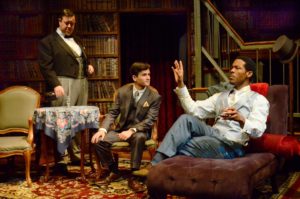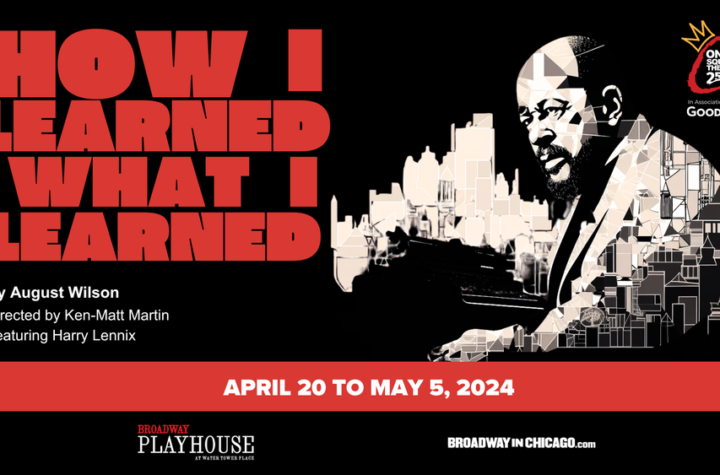
 Recommended ***In the days before talkies, color movies, radio, television, and video, it was theatre that brought whodunits to admiring audiences. Lifeline Theatre has continued this tradition by staging its elegant production of “Whose Body?”, based on Dorothy Sayers’ 1923 classic thriller. Its skillful adaption for the Lifeline stage by Frances Limoncelli will most certainly pique the interest of a new generation of spectators, some of whom might be drawn to pick up the original novel.
Recommended ***In the days before talkies, color movies, radio, television, and video, it was theatre that brought whodunits to admiring audiences. Lifeline Theatre has continued this tradition by staging its elegant production of “Whose Body?”, based on Dorothy Sayers’ 1923 classic thriller. Its skillful adaption for the Lifeline stage by Frances Limoncelli will most certainly pique the interest of a new generation of spectators, some of whom might be drawn to pick up the original novel.
The first thing the audience notices on walking into the auditorium is the Harry Potter-like ambiance of the set with its multi-level layers of stages, complete with ascending wooden staircase. Half the audience probably used the Potter reference to describe their feelings of mystical enchantment. This is also how the modern generation of Americans might perceive of a bygone era of English nobility and privilege, where vast numbers of books and antique furnishings marked a wealthy family’s high status and influence.
Later as the play progresses, we can observe just how the highly inventive mechanical components function on stage in tandem with the storyline. This, plus the amble props (and the characters’ easy use of them), is the craft of Alan Donahue, the scenic and props wizard. How nicely he transports us back to old-tyme England between World Wars One and Two! 
The overriding question at hand is whether this whodunit is successful: whether it effectively engages the audience, does its job of keeping each of us guessing who the murderer might be, and satisfies each one of us once we know the resolution of the crime.
Let’s put aside this issue for the moment. Allow me first to heap immense praise on the production itself, starting with the phenomenally creative director Jess Hutchinson, who has the actors emote from different parts of the house. Without moving from our seats, the audience becomes a part of the show.
Then there’s the superb acting and casting. William Anthony sparkles in his role as Lord Peter Wimsey. The smooth performance of this African-American actor playing an English nobleman is highly laudable and believable. The fact that he can draw in all of the action throughout the entire show is nothing short of spectacular. Circles drawn around him include that of his butler (an incredibly faithful representation by Scott Danielson), his mother (Katie McLean Hainsworth), Inspector Parker from Scotland Yard (John Drea) and his counterpart Inspector Sugg (Joshua K. Harris), and an array of other characters including the neurologist Dr. Julian Freke and his assistant Cummings (both adroitly played by Tony Bozzuto) and the maid (Michaela Voit). All of these supporting actors go through several costume changes in the process of playing multiple roles convincingly with the illusion of simultaneousness.
can draw in all of the action throughout the entire show is nothing short of spectacular. Circles drawn around him include that of his butler (an incredibly faithful representation by Scott Danielson), his mother (Katie McLean Hainsworth), Inspector Parker from Scotland Yard (John Drea) and his counterpart Inspector Sugg (Joshua K. Harris), and an array of other characters including the neurologist Dr. Julian Freke and his assistant Cummings (both adroitly played by Tony Bozzuto) and the maid (Michaela Voit). All of these supporting actors go through several costume changes in the process of playing multiple roles convincingly with the illusion of simultaneousness.
The small flaw in the acting has to do with the (intentional) overreach of Harris as the Chicagoan J.P. Milligan. His character is far too reminiscent of the Saturday Night Live sketch from the early 1990s about “Da Bears.” It is so over-the-top that it isn’t funny, even as comic relief. After all, the play ought to retain its genre as a murder mystery.
Credit must also go to the co-costume designers Caitlan McLeaod and Anna Wooden, whose outfits are all beautiful and rich, using authentic patterns and finely crafted materials. The depiction of this era would have been far less realistic without their meticulous attention to detail.
Now let me rephrase the question that I posed earlier in this review: Does the show work?
The performance is pleasantly whimsical, as represented in the character of Lord Wimsey, a Renaissance man, who fancies himself a private investigator. The nobleman often reflects on the deadly seriousness of his pursuit, for if he were to make a mistake in identifying the wrong person as the murderer, he would have done everybody a disservice (a classic British understatement). He constantly has flashbacks to the time when he was a major in the (First) World War and suffers from bouts of—what we call today—PTSD, back then known as shellshock. These episodes cause him pain but also provide him with flashes of insight, including his suspicion as to whom the murderer might be.
By understanding the post-World War (One) historical context, we can better appreciate the whole story, but that doesn’t make us love it. Something essential is missing. To my taste, there is not enough mystery and intrigue. The script is much too predictable (and thus unsatisfying), especially in the second act.
Speaking of taste, allow me to digress. Creating outstanding theatre is like making the perfect soup. The quality, amount, proportion, and freshness of ingredients are all important to the recipe. The preparation has to be just right in order for the flavors to come together. Underlying it all is the most fundamental element: the soup base. So it is with theatre. In “Whose Body?” we see all the gloss and gilt on stage; we witness all the savory elements; but the show needs to be grounded in a meatier broth before moving on to the seasoning. (My apologies to the vegetarians among us.)
Above all, despite the painstaking attention to detail—from the compelling acting to the creative set design to the fine costuming, sound design and lighting—the script needs more freshness. The story, while appropriate to the 1920s, is dated: Today’s audiences demand a grittier, more action-oriented plot, with just enough horror to make it all feel real. There are times when I should have been on the edge of my seat, but I was not and felt deflated. In brief, the play fails to meet expectations, because it’s much too cerebral and old-fashioned. There are much better detective stories out there than this one, and many can be found on television.
“Whose Body?” is thus successful as a historical piece but not as a whodunit. It is a tasty morsel of this time period but not enough of a mystery to be devoured.
Reminiscent of the underground/subway which has rattled many a vintage London theatre, one can hear the whirring elevated train (“L”) atop Glenwood Avenue at stage left. A hundred years ago when Dorothy Sayers wrote her books, it was no different: Chicagoans and Londoners would have similarly heard the muffled sound of reverberating railcars from their comfortable seats. But any superficial resemblance between the two audiences is just that. The story that worked well in Britain between the wars falls flat today. Though highly polished, Lifeline’s performance of this London-based thriller is much too rooted in a singular time and place—and lacks the quidditch to launch it into the 21st century.
 “Whose Body?” runs through October 27th at Lifeline Theatre, 6912 N. Glenwood Avenue, Chicago. Free parking and shuttle buses are available.
“Whose Body?” runs through October 27th at Lifeline Theatre, 6912 N. Glenwood Avenue, Chicago. Free parking and shuttle buses are available.
Performances are Thursday and Friday at 7:30 p.m., Saturdays at 7:00 and 8:00 p.m., and Sundays at 4:00 p.m.
Tickets are $45
$20 for active and retired military personnel (with ID)
$35 for seniors
$20 for students (with ID)
$20 for rush tickets (available a half hour before show time, subject to availability)
Group rates for 12 or more are available on request.
Tickets may be purchased at the Lifeline Theatre Box Office, 773-761-4477, or by visiting www.lifelinetheatre.com.
The Sunday, September 29th 4:00 p.m. performance and the Friday, October 25th, 7:30 p.m. performance will feature open captioning for patrons who are deaf or hard-of-hearing.The Saturday, September 28th 4:00 p.m. performance will feature a pre-show touch tour for the set at 2:30 p.m. and live audio description for patrons who are blind or have low vision. Contact Erica Foster at 773-761-4477 x703 or access@lifelinetheatre.com for more information about accessible performances.
To see what others are saying, visit www.theatreinchicago.com, go to Review Round-Up and click at “Whose Body?”.






More Stories
“Barefoot in the Park”
“Joe Turner’s Come and Gone”
“How I Learned What I Learned” reviewed by Julia W. Rath